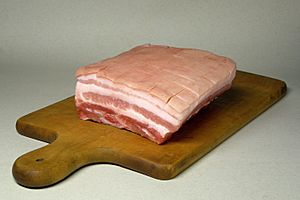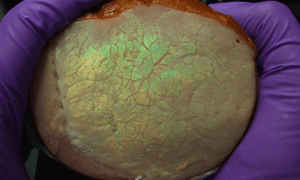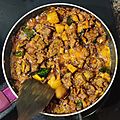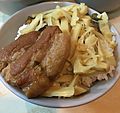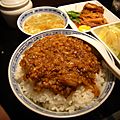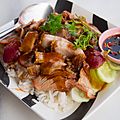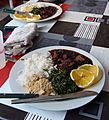Pork facts for kids
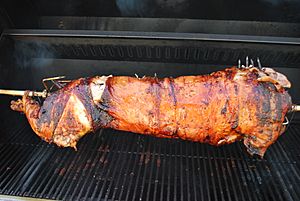
Pork is the name for meat that comes from a domestic pig. It's eaten by more people around the world than any other type of meat! People have been raising pigs for food for a very long time, even as far back as 5000 BC.
You can find pork in many popular foods. Things like sausages, bacon, and ham are common ways people enjoy pork in places like the United Kingdom and the United States. A simple dish with pork is called afelia.
Types of Pork Products
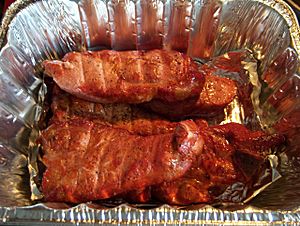
Pork can be cooked right away as fresh meat, or it can be cured. Curing means treating the meat with salt or smoke to preserve it. Popular cured pork products include ham and bacon. Different parts of the pig are used for various fresh meat cuts, and what's popular can change depending on where you are in the world.
Fresh Pork Meat
Almost every part of a pig can be used for fresh meat. Sometimes, a whole young pig, called a suckling pig, is roasted. These young pigs are usually between two and six weeks old.
In Denmark, a dish called flæskesteg is very popular. It's roast pork with crispy skin, and it's a traditional Christmas dinner.
Processed Pork Products
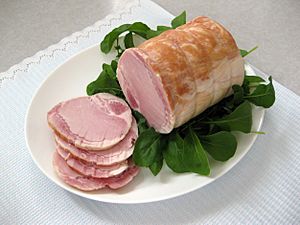
Pork is a main ingredient in many types of sausages. Lots of traditional European sausages, like chorizo, fuet, Cumberland sausage, and salami, are made with pork. Many hot dogs and most breakfast sausages in America also use pork. In France, the art of making processed pork products like sausages is called charcuterie.
Ham and bacon are made by curing fresh pork. This means treating the meat with salt (called pickling) or by smoking it. Ham usually comes from the pig's legs or shoulders. Bacon often comes from the side of the pig, either the belly (streaky bacon) or the loin (round bacon).
Ham and bacon are very popular in Western countries. Their use grew a lot as industries developed. Other cultures also use preserved pork. For example, salted pork and red roasted pork are common in Chinese and other Asian foods.
Bacon is meat cut from the sides, belly, or back of a pig that has been cured or smoked. In Europe, bacon is often cut into small cubes called lardons. These are used in cooking to add flavor and fat. In Italy, a type of bacon called pancetta is sometimes served uncooked in thin slices as an appetizer. Bacon can also be used to wrap roasts, especially game birds, to keep them moist. Bacon is often smoked for many hours using different types of wood. You can eat bacon fried, baked, or grilled.
A whole, unsliced piece of bacon is called a "flitch" or "slab bacon." A single slice of bacon is known as a "rasher" in places like Australia, Ireland, New Zealand, and the United Kingdom. In North America, it's usually just called a "slice" or "strip." Sometimes, slices of bacon are also called "collops." Traditionally, the skin is left on the bacon and is called "bacon rind," but you can also find bacon without the rind.
In Ireland and the United Kingdom, bacon comes in many cuts and flavors. "Streaky bacon" is very common. "Back bacon," which comes from the back of the pig, is part of the traditional full breakfast often eaten in Britain and Ireland. In the United States, back bacon is sometimes called "Canadian-style Bacon" or "Canadian Bacon."
The USDA says that bacon is "the cured belly of a swine carcass." If other parts are used, it needs to be specified, like "smoked pork loin bacon." If bacon is "USDA Certified," it means it has been treated to be safe from a parasite called Trichinella.
Another well-known canned meat product called Spam is made from chopped pork shoulder meat and ham.
Images for kids
-
A pig being prepared in France during the mid-19th century.
-
A traditional Austrian pork dish, served with potato croquettes, vegetables, mushrooms and gravy.
-
A pork shop in Dubai, United Arab Emirates.
-
A display of hams, pig's trotters, salamis, and mortadella in a pork butcher's shop in Bologna, Italy.
-
Grilled pork as a main dish on a Serbian Christmas table.
-
Sweet and sour pork, a Chinese dish popular in Europe and the Americas.
-
Red-colored charsiu is a popular way to prepare pork in Southern China.
-
Chinese Dongpo pork.
-
Chinese Dongpo pork.
-
Chinese Braised pork rice.
-
Chinese Minced pork rice.
-
Khao mu krop mu daeng, Thai crispy and red pork.
-
Bak kut teh, a pork ribs and offal soup from Malaysia and Singapore.
-
Batak-style Babi panggang, roasted pork belly from Indonesia.
-
Filet de Porc à la Bordelaise, a French-style pork tenderloin.
-
Feijoada, a typical Portuguese pork and beans dish, and the national dish of Brazil.
-
Chicharrón, Spanish fried pork rinds, found throughout the Hispanic world.
-
Porcheddu, a Sardinian suckling pig.
See also
 In Spanish: Carne de cerdo para niños
In Spanish: Carne de cerdo para niños


